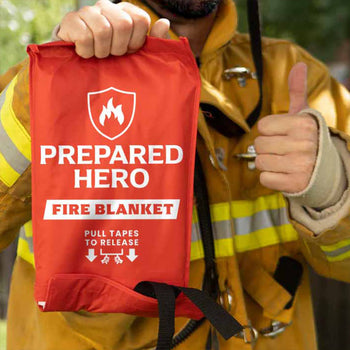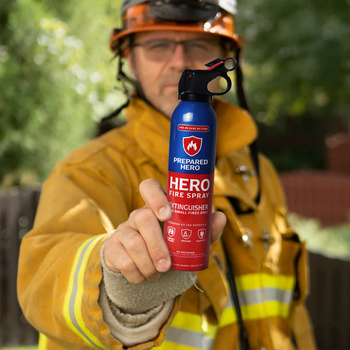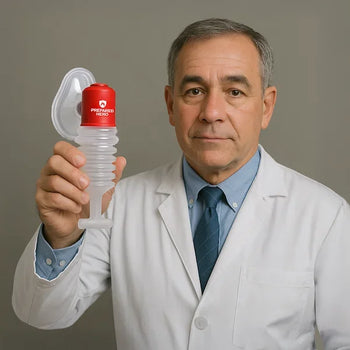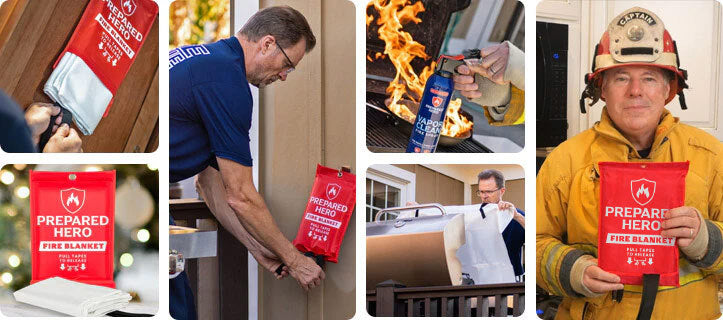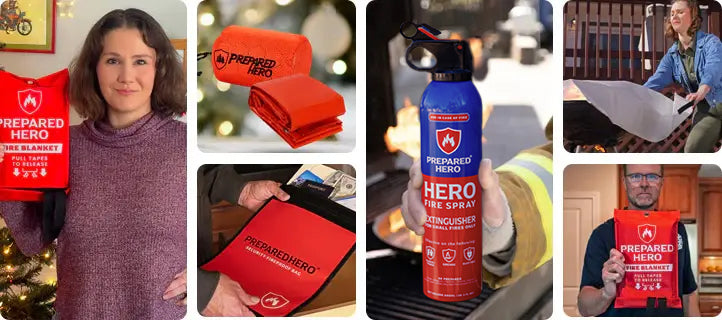Where you put your smoke detectors matters just as much as installing them. Proper placement makes sure they can detect...
Electrical fires caused an average of 430 deaths, 1,070 injuries, and $1.3 billion in property damage each year. While they’re unpredictable, you can prevent them from becoming a full-blown inferno.
But dealing with an electrical fire isn’t the same as putting out a paper fire gone rogue. They are more complicated because of the risk of electrocution. Water also makes them worse, and you need a specific extinguisher to put them out. Find out what type of fire extinguisher is used for electrical fires now.
What Are Electrical Fires?

Think about the electrical appliances, tools, and devices you use every day. We’re talking about smartphones, televisions, computers, toasters, coffee makers, stoves, and more. They make our lives easier, help us with chores, and let us work efficiently. But with all these electrical comforts comes a risk we shouldn’t ignore: electrical fires.
Electrical fires are fires that start from anything that uses electricity. These include lights, appliances, tools, and gadgets. Problems occur when electrical systems malfunction, overheat, or are misused. Common electrical issues include exposed wires, overloaded circuits, frayed cords, overheating electronics, and short circuits.
For instance, plugging too many appliances into one outlet can overload it. As a result, the wires can heat up and spark a fire. Similarly, old or damaged wires can create a dangerous situation, especially if not fixed or replaced on time. Even something as simple as leaving a space heater too close to a curtain can lead to an electrical fire.
Electrical fires are also silent but deadly. They can start behind walls and ceilings without warning. You might not even know there’s an issue until you smell something burning or see smoke. That’s why it’s important to check your appliances, avoid overloading outlets, and fix damaged wires as soon as possible.
While electrical fires are deadly, they can be prevented. Keeping flammable items away from appliances, installing smoke detectors, and having a fire prevention kit are just some of the things you can do to prevent electrical fires.
Are Electrical Fires Dangerous?

Yes, electrical fires are dangerous. For one, they can spread quickly without warning. Unlike some fire types caused by ordinary combustibles, electrical fires can start quietly, often behind walls or ceilings where you can’t see them. This means they could be growing for a while before you realize there’s a problem.
Electrical fires also spread fast. Since they start in wires, insulation, or appliances, they can easily run through your house’s electrical system. They can also burn other materials (e.g., wooden walls and carpets) as they go. This makes it hard to contain the fire and leads to extensive property damage. The danger doesn’t stop with property damage, though—electrical fires are also responsible for injuries and deaths.
Another reason electrical fires are dangerous is how people try to put them out. Water is never a good option when putting out electrical fires. It can conduct electricity and electrocute someone trying to stop the fire. That’s why it’s important to have a fire extinguisher made to put out electrical fires.
How Electrical Fires Start

The science behind these fires is simple: electricity flows through conductors (like wires). When there’s too much current or they get damaged, the wires can’t handle the load. The excess energy is released as heat, which, if not controlled, can start a fire.
Electrical fires start when something goes wrong with the electrical system in a device, appliance, or building. This causes heat to build up and ignite nearby materials. This usually happens because of faulty wiring, overloaded circuits, or malfunctioning appliances.
Wires are designed to carry a certain amount of electrical current. When there’s too much current flowing through them—because of damaged insulation, frayed wires, or an overloaded circuit—resistance builds up. This resistance generates heat that can reach temperatures high enough to ignite nearby materials, like wood, plastic, or insulation. For example, a frayed extension cord with exposed wires can cause sparks and heat to build up.
Faulty appliances can also cause electrical fires. If an appliance has problems with its wiring or is old and worn out, it can overheat and spark. Things like smartphones, computers, space heaters, coffee makers, toasters, and blowers are often involved in these.
In short, electrical fires happen when electrical systems, appliances, or devices generate too much heat, and the heat ignites something flammable.
What Type of Fire Extinguisher Is Used for Electrical Fires?

The type of fire extinguisher used for electrical fires is Class C. Electrical fires are hard to extinguish because they involve equipment that can electrocute you. They’re caused by issues such as:
- Damaged wires
- Overloaded outlets
- Faulty appliances
- DIY electrical work
- Overheating
- Poor maintenance
Class C fire extinguishers are made to put out electrical fires without electrocuting you. They also have minimal effect on the devices involved.
Class C carbon dioxide, powder, and water mist fire extinguishers can put out electrical fires. Carbon dioxide fire extinguishers work on electrical fires because they’re made of air. Hence, they don’t leave residues that could damage your appliances. Meanwhile, the agents in Class C powder fire extinguishers are poor conductors of electricity, making them suitable for electrical fires.
Contrary to popular belief, you can use water mist fire extinguishers on electrical fires because they’re made of deionized water with extremely small particles. They won’t electrocute you like regular water, making them safe against electrical fires.
Class C fire extinguishers have a specific symbol: a blue circle with the letter C inside it. The blue circle indicates that you can use the extinguisher to safely put out electrical fires. In some cases, the C doesn’t come with a blue circle. As long as you see the letter C on the label, you’re good to go. You can also use multi-purpose or ABC extinguishers to put out electrical fires. These fire extinguishers have the letters A, B, and C on them.
In most cases, electrical fire extinguishers come with numbers. The number before the letter C determines how many square feet the extinguisher can cover. For instance, a 10:C fire extinguisher can extinguish an electrical fire over 10 square feet.
Take note that you should never use water to put out electrical fires. Regular water conducts electricity, which puts you at risk of electric shocks. You should also turn off the power source before trying to put out an electrical fire.
Types of Fire Extinguishers

Here’s a quick rundown of the types of fire extinguishers used for different types of fire:
Class A Fire Extinguisher
A Class A fire extinguisher is designed to put out Class A fires caused by ordinary combustible materials like wood, paper, fabric, plastic, and rubber. They’re one of the most common fire types at home.
Class A fire extinguishers are usually water-based, though some have additives to improve their effectiveness. For example, water mist extinguishers use deionized water, while wet chemical extinguishers contain potassium to help cool the fire. Since Class A fires are caused by solid materials, using a water-based extinguisher is usually the best approach. However, you can’t use the said extinguisher against electrical fires.
Class A fire extinguishers have a specific symbol: a green triangle with the letter A inside. In some cases, the green triangle is not included on the label, and only the letter A is present. ABC fire extinguishers are also Class A fire extinguishers because they can put out fires caused by solid combustibles.
Class B Fire Extinguisher
A Class B fire extinguisher is made to fight Class B fires caused by flammable liquids and gases like gasoline, alcohol, paint thinners, and propane. These fires are tricky because they involve substances that can spread quickly or explode if not handled properly.
Class B fire extinguishers come in different forms, such as foam, powder, or carbon dioxide. Foam works against flammable liquids by creating a layer that puts out the fire and prevents it from reigniting. Powder extinguishers coat the fire to block the fuel from reacting with oxygen, while carbon dioxide displaces oxygen to smother the flames.
Class B extinguishers are marked with the letter B inside a red square. In some cases, only the letter B is on the container. ABC fire extinguishers are also Class B fire extinguishers because they can put out fires caused by flammable liquids and gases.
Class C Fire Extinguisher
A Class C fire extinguisher puts out Class C fires caused by faulty wiring, overloaded outlets, malfunctioning appliances, DIY electrical work, and the like.
Class C fire extinguishers contain agents like carbon dioxide, powder, or water mist. Carbon dioxide doesn’t leave any residue, so it protects electronics. Meanwhile, Class C powder extinguishers create a barrier between the flames and oxygen. Water mist, on the other hand, uses very fine particles of deionized water that don’t conduct electricity.
You’ll spot a Class C extinguisher by the blue circle with the letter C inside. In some cases, you can only find the letter C on the label. Never use water on electrical fires because it can lead to electric shocks. ABC fire extinguishers are also Class C fire extinguishers because they can put out electrical fires.
Class D Fire Extinguisher
A Class D fire extinguisher is designed to handle Class D fires caused by metals like magnesium, lithium, and titanium.
It’s made of powder―usually a mix of graphite or sodium chloride. The agent works by creating a barrier between the burning metal and oxygen. The powder also helps cool down the fire and prevents it from spreading. Class D fire extinguishers are usually found in industrial settings or anywhere that processes metals.
A Class D extinguisher has the letter D inside a yellow star. In some cases, you can see the letter D without the star.
Class K Fire Extinguisher
A Class K fire extinguisher puts out Class K fires caused by grease, fat, or oil. Unlike solid combustible fires, you can’t put them out with water.
These extinguishers are made of wet chemicals. The agents are usually a mix of potassium acetate, potassium carbonate, potassium citrate, or a combination of the said compounds. When sprayed on a grease fire, the wet chemicals react with the oils and create a soapy layer that cools the fire, smothers it, and prevents it from reigniting.
A Class K fire extinguisher usually has a black hexagon with the letter K inside. In some cases, the container comes with the letter K without the black hexagon.
How to Use a Fire Extinguisher on an Electrical Fire

Using a fire extinguisher on an electrical fire requires extra care because it involves appliances that can shock you. Here’s how to safely use a fire extinguisher on an electrical fire:
1. Make Sure It's Safe
Check if it’s safe to fight the fire before getting the fire extinguisher. If you can, turn off the power supply. Doing this reduces the risk of electrical shock. Don’t risk your safety—if you feel unsafe or the fire is spreading fast, leave your house or office immediately.
2. Grab the Right Extinguisher
Make sure you have the right extinguisher for the job: a Class C fire extinguisher. It’s made to fight fires involving electrical equipment like computers, toasters, or power cords. Look at the label on the extinguisher to check if it's rated for electrical fires. Don’t use water as well because it conducts electricity and can electrocute you. Using the wrong extinguisher, like one made for grease fires, can make the fire worse. If you don’t have the right extinguisher, leave the area and call for help.
3. Use the PASS Method
The PASS fire extinguisher protocol stands for Pull, Aim, Squeeze, and Sweep. Safety experts made this acronym short and direct to the point so you can easily remember how to use a fire extinguisher.
- Pull the safety pin.
- Aim the nozzle at the base of the fire.
- Squeeze the handle to release the extinguishing agent.
- Sweep the nozzle from side to side until the fire is out.
Don't get too close to the flames—stand a few feet away so you won’t get burned.
4. Monitor the Affected Area
Keep an eye on the area even if the fire is out. Electrical fires can sometimes reignite. If you see smoke or small flames reappearing, use the fire extinguisher to put it out. If it looks like the fire is out for good, you should still call a professional to check the area. Electrical fires often happen because of faulty wiring or equipment, so you have to fix the problem before turning anything back on.
5. Know When to Stop
Don’t try to put out the fire if the flames are too big or out of control. Don’t waste time trying to fight it—just evacuate and call the fire department. Don’t take chances and let the professionals handle it. Once you’re safe, don’t go back inside until the fire department says it's safe.
How to Maintain Fire Extinguishers Used for Electrical Fires
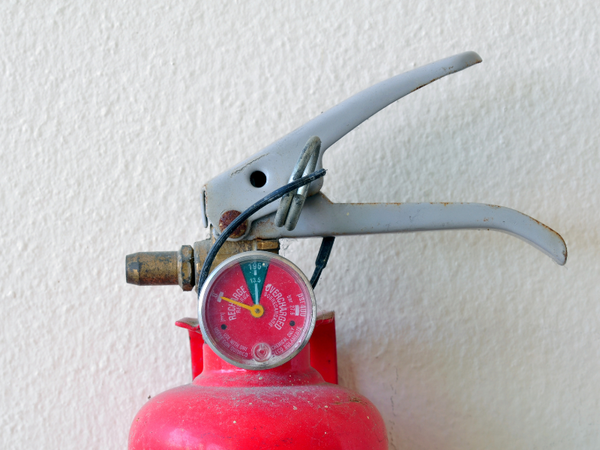
Electrical fires are unpredictable and dangerous, so keeping your electrical fire extinguisher in top shape could make all the difference in preventing injuries and damages. Here’s how to maintain fire extinguishers used for electrical fires:
1. Check the Pressure
Check if the needle is in the green zone, which indicates proper pressure. If it's in the red zone, the extinguisher won’t work properly. If this happens, have your electrical fire extinguisher refilled or replaced.
2. Inspect for Damage
Inspect the fire extinguisher for any signs of physical damage once a month. Look for dents, rust, or cracks in the container that might compromise the extinguisher. Then, make sure the safety pin is in place.
The nozzle and hose should also be free from any clogs, cracks, or obstructions. If the nozzle is damaged or the hose is bent or blocked, the extinguisher might not release the agent when needed.
3. Check the Expiration Date
Most fire extinguishers need to be serviced or replaced every five to twelve years, depending on the manufacturer. If the label shows the extinguisher is expired, it’s time to get a new one.
4. Do Hydrostatic Testing
Your electrical fire extinguisher needs to undergo hydrostatic testing, depending on manufacturer guidelines. This test checks for any weaknesses or leaks in the cylinder. This test also lets you comply with safety regulations.
5. Store Your Extinguisher Properly
Keep your electrical fire extinguisher away from heat sources, moisture, and direct sunlight. It’s best to mount it on a wall or keep it in a visible spot so you can grab it quickly during a fire emergency.
What’s in a Class C Fire Extinguisher?

A Class C fire extinguisher is made of different materials depending on the exact type, but they all work against electrical fires. One common agent is made of carbon dioxide (CO2). It doesn’t leave any residue behind, so it won’t damage your electronics or appliances. It also displaces oxygen and cools things down.
Another type of Class C extinguisher contains powder, like sodium bicarbonate and potassium bicarbonate. This powder forms a barrier over the fire and cuts off its oxygen supply.
Lastly, some newer Class C extinguishers are made of water mist. It contains deionized water that doesn’t conduct electricity, making it safe for electrical fires. It also cools down the fire and prevents it from spreading.
Is an ABC Fire Extinguisher Good for Electrical Fires?

Yes, an ABC fire extinguisher is good for electrical fires. The ABC mark means that it can put out three types of fires: Class A (caused by solid combustibles), Class B (caused by flammable liquids and gases), and Class C (caused by electrical equipment).
ABC extinguishers usually contain a dry chemical powder, such as monoammonium phosphate, that works by removing oxygen from the equation. The powder doesn’t conduct electricity, so you won’t get shocked.
What Extinguishers Should Not Be Used on Electrical Fires?

You shouldn’t use water, wet chemical, and foam fire extinguishers on electrical fires. Water fire extinguishers are one of the most dangerous things you can use on an electrical fire. Water conducts electricity, which means that if you spray it on an electrical fire, you could get electrocuted. Water can also cause the fire to spread, especially if it's an electrical fire involving live wires or devices.
You should also not use wet chemical fire extinguishers on electrical fires. These extinguishers are designed to create a barrier over burning fats and oils but are not intended for electrical hazards. The chemicals inside can also conduct electricity, increasing the risk of electrocution. Foam fire extinguishers are not safe for electrical fires as well. They’re typically used for Class A and Class B fires. But just like water, foam can conduct electricity.
Alternatives to Extinguishers Used for Electrical Fires

While Class C fire extinguishers put out electrical fires quickly, they can be expensive, heavy, bulky, and hard to store. They might also contain toxic chemicals and leave residues that are hard to clean up.
The Vapor Clean Fire Spray and Dry Stop Fire Spray are easy-to-use, lightweight, and affordable alternatives to Class C fire extinguishers. These fire sprays are also biodegradable and non-toxic. Unlike a fire extinguisher, you can safely use them around your family and pets.
Here’s a table summarizing the differences between the said fire sprays and a regular Class C fire extinguisher:
|
Prepared Hero’s Fire Spray |
Regular Fire Extinguisher |
|
Lightweight, easy to carry |
Heavy, hard to carry |
|
Affordable |
Expensive |
|
Easy to store |
Needs more space for storage |
|
100% biodegradable |
Mostly made of non-biodegradable materials |
|
Non-toxic |
Toxic |
|
Easy to clean |
Hard to clean |
|
Safe for kids and pets |
Not safe for kids and pets |
Another alternative is a fire blanket, which removes the fire’s oxygen supply. By doing this, it puts out small Class C fires in seconds. It also doesn’t leave a mess because it just covers the fire.
Unlike fire extinguishers, Prepared Hero’s fire blanket doesn’t expire. You can reuse it as many times as you want as long as it’s not damaged. Plus, you can use it to save someone on fire.
Here’s a table summarizing the differences between Prepared Hero’s fire blanket and a regular Class C fire extinguisher:
|
Prepared Hero’s Fire Blanket |
Regular Fire Extinguisher |
|
Lightweight, easy to carry |
Heavy, hard to carry |
|
Affordable |
Expensive |
|
Doesn’t expire |
Expires |
|
Easy to store |
Needs more space for storage |
|
Non-toxic |
Toxic |
|
Doesn’t leave a mess |
Leaves a mess |
|
Safe for kids and pets |
Not safe for kids and pets |
|
Can be used on humans |
Can’t be sprayed on humans |
Do you want reliable, easy-to-use, and affordable tools to put out Class C fires? Check out Prepared Hero’s fire prevention tools here, and get up to 51% off on certain items. Stay prepared, hero!


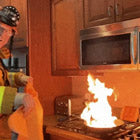 Fire
Fire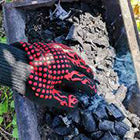 Safety
Safety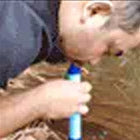 Survival
Survival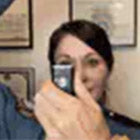 Protection
Protection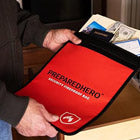 New
New Scouting America
Scouting America
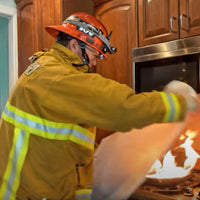 Fire
Fire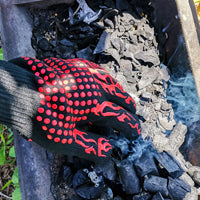 Safety
Safety Survival
Survival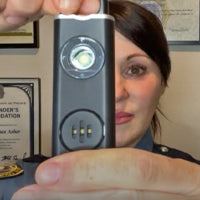 Protection
Protection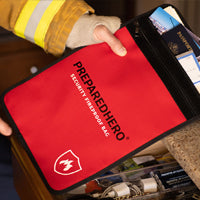 New
New
